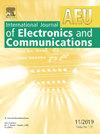安全神经刺激医疗系统植入式天线的生物真实感评价
IF 3.2
3区 计算机科学
Q2 ENGINEERING, ELECTRICAL & ELECTRONIC
Aeu-International Journal of Electronics and Communications
Pub Date : 2025-09-27
DOI:10.1016/j.aeue.2025.156054
引用次数: 0
摘要
这项工作展示了一种罗马马赛克启发的弯曲线天线,具有缺陷地面结构(DGS),用于2.45 GHz ISM频段的神经刺激器植入装置。超小型天线占地面积为4 × 4 × 0.635 mm3,是可植入天线文献中报道的最小的天线之一。弯曲的几何形状和DGS的结合引入了慢波效应,有效地扩展了电流路径,并在这个受限的体积内实现了共振。在Rogers 6010衬底上制造,该天线具有34.3% (840 MHz)的显著分数带宽,测量时峰值增益为- 17.1 dBi。在组织等效条件下对带电池的封装原型进行了评估,证实了其出色的天线性能。本设计符合IEEE C95.1 SAR标准。热分析表明温升在安全范围内,不超过1℃。天线在温度上升和附近有电子设备存在的情况下保持稳定运行。详细的链路预算分析评估了系统在不同比特率下的性能。结果证实了该天线在长期、安全、高效的基于神经刺激器的生物遥测中的适用性。本文章由计算机程序翻译,如有差异,请以英文原文为准。
Bio-realistic evaluation of an implantable antenna for safe neurostimulation medical system
This work demonstrates a Roman mosaic-inspired meandered-line antenna with a Defected Ground Structure (DGS) for neurostimulator implant devices in the 2.45 GHz ISM band. The ultra-miniaturized antenna has a compact footprint of 4 × 4 × 0.635 mm3, one of the smallest reported in implantable antenna literature. The combined meandered geometry and DGS introduce a slow-wave effect, effectively extending the electrical current path and enabling resonance within this constrained volume. Fabricated on a Rogers 6010 substrate, the antenna has a significant fractional bandwidth of 34.3 % (840 MHz) with −17.1 dBi peak gain when measured. Evaluations of the packaged prototype with battery under tissue-equivalent conditions confirm excellent antenna performance. The design complies with IEEE C95.1 SAR limits. Thermal analysis indicates temperature rise within the safety margins, not more than 1 °C. The antenna maintains stable operation under temperature rise and in the presence of nearby electronic devices. A detailed link budget analysis evaluates the system performance at different bitrates. The results affirm the suitability of the proposed antenna for long-term, safe, and efficient neurostimulator-based biotelemetry.
求助全文
通过发布文献求助,成功后即可免费获取论文全文。
去求助
来源期刊
CiteScore
6.90
自引率
18.80%
发文量
292
审稿时长
4.9 months
期刊介绍:
AEÜ is an international scientific journal which publishes both original works and invited tutorials. The journal''s scope covers all aspects of theory and design of circuits, systems and devices for electronics, signal processing, and communication, including:
signal and system theory, digital signal processing
network theory and circuit design
information theory, communication theory and techniques, modulation, source and channel coding
switching theory and techniques, communication protocols
optical communications
microwave theory and techniques, radar, sonar
antennas, wave propagation
AEÜ publishes full papers and letters with very short turn around time but a high standard review process. Review cycles are typically finished within twelve weeks by application of modern electronic communication facilities.

 求助内容:
求助内容: 应助结果提醒方式:
应助结果提醒方式:


